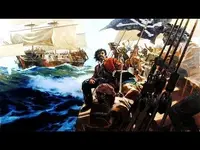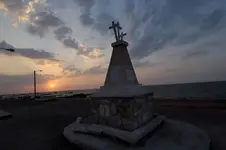“History” and “Logic” are not often "Printed" on the "Same Pages".
 “History” and “Logic” are not often printed on the same pages.
“History” and “Logic” are not often printed on the same pages.
Although I am not as knowledgeable as some of the members on this “forum” who have studied the episodes of “Jean Lafitte”, I would like to offer another version of what may have happened to Captain Lafitte.
It is strange that he was hardly ever referred to as “Captain” unlike Captain Morgan,
Captain Every, or the famous Captain Kidd.
I base my presentation more on
“Logic” than recorded
“Historical Facts”.
My belief concurs with history that in 1821 the United States evicted “Captain Lafitte” from Texas.
He was in the Texas Peninsula to raid Spanish ships leaving the Port of Veracruz to Cuba and then to Spain.
He left on his ship the
“Pride” and went to
"Dzilam De Bravo" in the
"Yucatan Peninsula, Mexico".
I believe he was well acquainted with this small Mayan Village, which I will clarify latter.
Unfortunately, Mexico had just received its independence from Spain (1821) and no longer would support raids on Spanish Ships.
The only country willing to support these raids was
“Colombia”.
Like John Dillinger’s famous saying
“I rob banks because that is where the money is”
So, Jean Lafitte followed the advantages and availability of plundering Spanish Galleons.
I believe there is an Island (5 Kilometers in diameter) located 17 Kilometers off the coast of the Yucatan Peninsula due north of Progreso that Captain Lafitte used for his Treasury.
Captain Lafitte left his treasure on this
“Atoll” and preceded to Colombia with his family and Brother Pierre with his ship the
“Pride”.
There he befriended
"General Santander" who I believe over
"General Bolivar" was the catalyst for South America’s final independence from Spain.
He traded his ship the
“Pride” for a 43 ton Schooner he named in honor of the General
“General Santander".
This time in history Spain had minimal war involvement in Europe, so Spain could afford to escort her treasure ships with heavy armed
“Armadas”.
Lafitte needed a
“faster” "Better Armed” Ship.
Here is where
“Logic” must supersede
“History”
I believe
“Lafitte” was returning to
"Dzilam De Bravo" with the
“General Santander”, with his family and brother Pierre and daughter.
I believe he was going to retrieve his treasure at the
“Atoll” and return to
“Colombia”.
I believe he would not have attacked 2 Spanish War Ships with his family on board.
He had been credited with plundering over 100 ships and would not have made a grave mistake as this.
He did not have
“yellow fever” as history stated.
Yellow fever kills multiple people and with only Jean suffering with this ailment it is hard to believe that only Lafitte would die from such a contagious disease.
The Maya at Dzilam De Bravo would have been fearful of
“Yellow Fever” and would have spoken on this.
From my knowledge of the
“Yucatan Coast” no one sails into
"Dzilam De Bravo" without knowing exactly where it is located.
The whole
“Yucatan Peninsula” has a very shallow coast line and only 2 points of entry, Dzilam De Bravo and Progreso.
Due to the extremely shallow coast line a vessel cannot cruse the shoreline looking for this location.
I have lived in the Yucatan Peninsula, married a Mayan, and conversed with the local Maya on Folk Lore.
Their culture does not depend on written history.
The only form of written history was by their Priests on Rock Stelas or the Catholic Priests recorded books.
Their form of verbal story telling (what we view as gossip) has been very accurate over many Centuries.
What they stated happened at Dzilam De Bravo, I would tend to believe.
I believe the account they told me to be true.
That Jean was well known to them.
That Pierre’s daughter
“Lucia” had a "Fiancé" in the village.
That the occurrence of a
“Schooner” docking off their shores would have been recognized and recorded.
When our helicopter arrived at this village in the 80’s all the town came out to welcome us.
I am sure to this day that they verbally recorded the visit by
“Robot”.
It was stated that Jean Lafitte was gravely ill with an
“Appendicitis” requiring surgery.
They did not have the facilities to help him and proceeded by horse cart to
“Merida”, 1 week away for assistance.
He died on route.
I do not believe that
“Pierre Lafitte, (his brother) knew where the location of this
“Treasure Atoll” was.
If this is the
“Case” and this story is
"True" then I am willing to provide the
“Co-ordinates” to any adventurous
“Treasure Hunter” willing to
“Bribe” Mexican authorities for their
“Assistance”.





